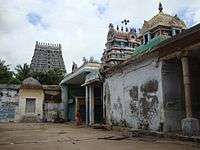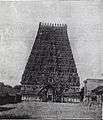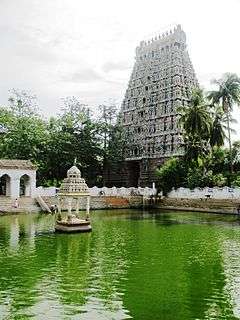Mayuranathaswami Temple, Mayiladuthurai
| Mayuranathaswami temple | |
|---|---|
|
Gopura of the Mayuranathaswami Temple | |
 Mayuranathaswami temple Location within Tamil Nadu | |
| Name | |
| Proper name | Mayuranathaswami Koil |
| Tamil | மயூரநாதசவாமி திருக்கோயில் |
| Geography | |
| Coordinates | 11°0′N 79°15′E / 11.000°N 79.250°ECoordinates: 11°0′N 79°15′E / 11.000°N 79.250°E |
| Country | India |
| State | Tamil Nadu |
| District | Nagapattinam |
| Location | Mayiladuthurai |
| Culture | |
| Primary deity | Mayuranatha Swamy(Shiva) |
| Architecture | |
| Architectural styles | Dravidian architecture |
The Mayuranathaswami Temple (Tamil: மயூரநாதசவாமி திருக்கோயில்) or Mayuranathar Temple is a Hindu temple in the town of Mayiladuthurai (formerly known as Mayavaram or Mayuram) in the Nagapattinam District of Tamil Nadu in India. The temple is dedicated to the Hindu god Shiva and has given its name to the town itself.[1]
The main icon is a lingam and the presiding deity is called Mayuranathar because the Hindu goddess Parvathi worshipped Shiva here in the form of a mayura.
On the day of the new moon in the Tamil month of Aippasi (November–December), religious Hindus have a ceremonial bath in the temple tank as it is believed to purify them from sins. An annual dance festival called the Mayura Natyanjali festival is celebrated within the precincts of the temple each year.
Location
The Mayuranathaswami temple is located in the southern part of Mayiladuthurai about a mile from the Kaveri River.[2] The temple is on the Chidambaram–Thanjavur highway.[3]
Icons

The presiding deity is a swayambhu lingam or a self-manifested lingam, the symbol of the Hindu god Shiva. Shiva's consort is known by the names Abhayapradhambikai, Abhayambikai, Anjalanayaki and Anjalai. There are three smaller shrines to the Hindu god Ganesha and another to Shiva as Nataraja or "Lord of Dance".
One of the sculptures in the temple represent Shiva embracing Goddess Parvathi.[4]
Myths
According to mythology, the goddess Parvathi, the consort of Shiva, once offended him.[4] Shiva was so annoyed he cursed Parvathi to be born as a lowly peahen.[4] Later, when Parvathi repented, Shiva reduced this sentence.[4] Parvathi had to pray first at Mylapore and then at Mayiladuthurai, at the end of which she was ridden of her curse and became known as "Abhayambal".[4]
History

The temple was built by the Medieval Cholas. The oldest inscriptions on the temple walls date to the time of Kulothunga Chola I.[5] Massive renovations were carried out in the 17th century. In May 1927, a temple entry of Dalits was organised on a big scale by the proponents of the Self Respect Movement thereby resulting in a huge clash.[6]
Architecture
The temple complex is 719 feet (219 m) long and 52 feet (16 m) wide. The gopura at the eastern entrance to the temple is nine storeys high[2] and measures 194 feet (59 m). The idol of Durga near the northern entrance of the temple is expertly sculpted and differs from those in other temples.[2] On the temple walls, there is the sculpture of a devotee trying to sever his head as an offering to the God.[2]
There is an expansive temple tank in the centre of the complex. People travel in large numbers to Mayiladuthurai to bathe in this tank on the day of the new moon in the Tamil month of Aippasi (November–December). This bath purifies a person of sins because the waters of the river Ganges and other Indian rivers mingle with the waters of the Kaveri river in this tank on this particular day.[7]
Gallery
 Historic image of the temple gopuram
Historic image of the temple gopuram Entrance of one of the shrines
Entrance of one of the shrines
Notes
- ↑ The Imperial Gazetteer of India 1908, Vol 17. Clarendon Press. 1908. p. 238.
- 1 2 3 4 Tourist Guide to Tamil Nadu. Sura Books. p. 64. ISBN 81-7478-177-3, ISBN 978-81-7478-177-2.
- ↑ Nanditha Krishna (2002). Sacred tanks of South India. C.P.R. Environmental Education Centre. p. 227.
- 1 2 3 4 5 Ayyar, p 271
- ↑ Ayyar, p 280
- ↑ S. V. Rajathurai (1998). Towards a non-Brahmin millennium: from Iyothee Thass to Periyar. Samya. p. 224. ISBN 8185604371, ISBN 978-81-85604-37-4.
- ↑ Ayyar, p 249
References
| Wikimedia Commons has media related to Mayuranathaswami Temple, Mayiladuthurai. |
- P. V. Jagadisa Ayyar (1920). South Indian shrines: illustrated. Madras Times Printing and Pub. Co.



